
aki no no ni
sakitaru hana o
yubi orite
kaki kazoureba
nana kusa no hana.
hagi ga hana
obana kuzubana
nadeshiko no hana
ominaeshi
mata fujibakama
asagao no hana.
---------------------
Flowers blossoming
in autumn fields -
when I count them on my fingers
they then number seven
The flowers of bush clover,
eulalia, arrowroot,
pink, patrinia,
also, mistflower
and morning faces flower.
Yamanoue Okura (C. 660 - 733)
Manyoshu: 8:1537-8
Autumn brings with it a certain sadness at the passing
of fair summer days and the coming of cold winter. It also
brings a beauty celebrated throughout the world. Autumn
is a time when mountains turn to magnificent crimson tapestries
and cities glow in wonderful autumnal tints as days grow
cooler. Autumn has long been particularly extolled in Japanese
poetry, painting, and design.
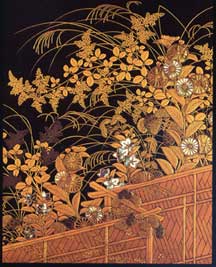 The
seven grasses of autumn (aki no nanakusa)
were often mentioned in verses of the Manyoshu,
the earliest collection of Japanese poetry and song. Images
of autumn grasses in a later anthology of court poetry,
the Kokinshu, illustrate the culture of Heian
Japan [784 - 1185] in a way that could not be captured
by painting. Powerful and concise language draws out the
subtle nuances of life and love at the time, just as nature
and flowers invoke the mutable seasons of interior emotion. The
seven grasses of autumn (aki no nanakusa)
were often mentioned in verses of the Manyoshu,
the earliest collection of Japanese poetry and song. Images
of autumn grasses in a later anthology of court poetry,
the Kokinshu, illustrate the culture of Heian
Japan [784 - 1185] in a way that could not be captured
by painting. Powerful and concise language draws out the
subtle nuances of life and love at the time, just as nature
and flowers invoke the mutable seasons of interior emotion.
It is through Yamanoue Okura’s coupled
verse above that the seven autumn grasses gained renowned.
While it is uncertain who grouped these grasses together
for the first time, they have indeed become deeply rooted
in Japan’s daily life and history. Their presence
in the gardens of the Heian aristocracy may well have been
a great source of poetic inspiration, and still today grace
gardens and fields.
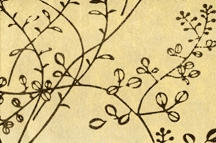 The
first mentioned bush clover (hagi or Lespedeza
japonica) appears over one hundred times in the Manyoshu,
making it the most well known of the autumn grasses. A deciduous
shrub of the pea family, bush clover can be found growing
wild in fields and mountains in Japan. Although most of
the seven grasses were not eaten, in olden times the seeds
of hagi were ground and mixed with rice gruel, while the
leaves were used as a substitute for tea. The arch of its
long, overhanging branches laden with reddish-purple flowers
and swaying in the wind makes an indelible impression. The
delicate flowers scatter as soon as crisp autumn breezes
begin. In The Tale of Genji, an early eleventh
century novel which has been called the greatest work in
Japanese literature, as Genji’s wife Murasaki lies
on her deathbed, she is visited by Genji and his daughter,
the empress. Their thoughts move to the hagi growing in
Murasaki’s garden as they make final farewells. A
corresponding scene in a 12th century Illustrated Tale
of Genji handscroll shows Genji, Murasaki, and the
empress in a room on the right of the picture while hagi
petals float away with the wind on the left. The
first mentioned bush clover (hagi or Lespedeza
japonica) appears over one hundred times in the Manyoshu,
making it the most well known of the autumn grasses. A deciduous
shrub of the pea family, bush clover can be found growing
wild in fields and mountains in Japan. Although most of
the seven grasses were not eaten, in olden times the seeds
of hagi were ground and mixed with rice gruel, while the
leaves were used as a substitute for tea. The arch of its
long, overhanging branches laden with reddish-purple flowers
and swaying in the wind makes an indelible impression. The
delicate flowers scatter as soon as crisp autumn breezes
begin. In The Tale of Genji, an early eleventh
century novel which has been called the greatest work in
Japanese literature, as Genji’s wife Murasaki lies
on her deathbed, she is visited by Genji and his daughter,
the empress. Their thoughts move to the hagi growing in
Murasaki’s garden as they make final farewells. A
corresponding scene in a 12th century Illustrated Tale
of Genji handscroll shows Genji, Murasaki, and the
empress in a room on the right of the picture while hagi
petals float away with the wind on the left.
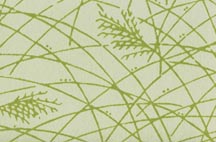 The
second named susuki (eulalia or Miscanthus
sinensis) is sometimes called obana or
‘tail flower’ because its feathery white flower
looks like an animal’s tail when it blooms in early
autumn. A well known Zen phrase describes this scene, “A
white horse enters a tail flower field (hakuba roka
ni iru). From a distance the two are indistinguishable,
yet the white horse remains the white horse, the tail flower,
tail flower--an illustration of the Zen paradox of not one,
not two. Closely associated with the autumn moon, the silver
tassels of susuki tossing in the wind have become inseparable
from the ambiance of the moonlit sky. Growing to heights
of sixty inches or more, this perennial herb of the Graminae
family grows wild on the hills and fields of Japan and other
East Asian countries. The well known poetic reference to
the Plains of Musashi or Musashino conjures images of a
vast distance overgrown with plumes of susuki as far as
the eye can see. The
second named susuki (eulalia or Miscanthus
sinensis) is sometimes called obana or
‘tail flower’ because its feathery white flower
looks like an animal’s tail when it blooms in early
autumn. A well known Zen phrase describes this scene, “A
white horse enters a tail flower field (hakuba roka
ni iru). From a distance the two are indistinguishable,
yet the white horse remains the white horse, the tail flower,
tail flower--an illustration of the Zen paradox of not one,
not two. Closely associated with the autumn moon, the silver
tassels of susuki tossing in the wind have become inseparable
from the ambiance of the moonlit sky. Growing to heights
of sixty inches or more, this perennial herb of the Graminae
family grows wild on the hills and fields of Japan and other
East Asian countries. The well known poetic reference to
the Plains of Musashi or Musashino conjures images of a
vast distance overgrown with plumes of susuki as far as
the eye can see.
 The
only one of the seven grasses used in cooking is arrowroot
(kuzu, Pueraria lobata). Its root is pounded,
and the white starch that remains is dried, powdered, and
used as a thickening agent in many styles of cooking. A
summer sweet made from very thick kuzu is often served in
chanoyu. The kuzu plant is a perennial, herbaceous, climbing
vine of the pea family. It clusters thickly at forest edges,
producing reddish-purple flowers shaped like butterflies.
However it was the leaves of the plant most often noted
by poets and painters during the Heian period. Thick and
green on top, the underside is pale white. The beauty of
arrowroot leaves blowing in the wind was thought to be sublimely
white and pretty by Sei Shonagon, author of the 11th century
classic, The Pillow Book. The melancholy of its
fluttering leaves was also used to great expressive effect
in the Shrine in the Field (Nonomiya) chapter of The
Tale of Genji, as a woman whom Genji had loved separates
herself from the world. The
only one of the seven grasses used in cooking is arrowroot
(kuzu, Pueraria lobata). Its root is pounded,
and the white starch that remains is dried, powdered, and
used as a thickening agent in many styles of cooking. A
summer sweet made from very thick kuzu is often served in
chanoyu. The kuzu plant is a perennial, herbaceous, climbing
vine of the pea family. It clusters thickly at forest edges,
producing reddish-purple flowers shaped like butterflies.
However it was the leaves of the plant most often noted
by poets and painters during the Heian period. Thick and
green on top, the underside is pale white. The beauty of
arrowroot leaves blowing in the wind was thought to be sublimely
white and pretty by Sei Shonagon, author of the 11th century
classic, The Pillow Book. The melancholy of its
fluttering leaves was also used to great expressive effect
in the Shrine in the Field (Nonomiya) chapter of The
Tale of Genji, as a woman whom Genji had loved separates
herself from the world.
 Nadeshiko
(Dianthus superbus, commonly called pink) is sometimes referred
to as wild carnation because it looks like a delicate relation
of florists’ carnations. Small fringed petals, five
in number, cluster on thin stems. Usually pink in color,
white varieties also exist. In Japanese the name literally
means “an affectionate touch for a child,” indicating
how endearing this flower is. The Manyoshu treats
dianthus as both a summer and an autumn flower, but later
it appears almost exclusively in mid to late summer context.
Several varieties of nadeshiko may be found along riverbanks,
on fields of eulalia, by the ocean shore, and along bluffs.
Another frequent poetic reference for dianthus is tokonatsu,
although it has a more romantic connotation. Nadeshiko
(Dianthus superbus, commonly called pink) is sometimes referred
to as wild carnation because it looks like a delicate relation
of florists’ carnations. Small fringed petals, five
in number, cluster on thin stems. Usually pink in color,
white varieties also exist. In Japanese the name literally
means “an affectionate touch for a child,” indicating
how endearing this flower is. The Manyoshu treats
dianthus as both a summer and an autumn flower, but later
it appears almost exclusively in mid to late summer context.
Several varieties of nadeshiko may be found along riverbanks,
on fields of eulalia, by the ocean shore, and along bluffs.
Another frequent poetic reference for dianthus is tokonatsu,
although it has a more romantic connotation.
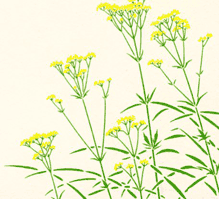 Ominaeshi
(Patrinia scabiosaefolia, patrinia), is a perennial herb
that grows in sunny fields of eulalia and mountainous areas
extending from Japan to Korea, China, and Eastern Siberia.
Sometimes referred to as “maiden flower,” the
tall stems of the ominaeshi fan out symmetrically at the
top, bearing tiny five-petaled flowers that resemble miniature
parasols. In classic Japanese literature, the flower’s
gentle appearance was likened to a beautiful woman and again
has romantic overtones. Ominaeshi
(Patrinia scabiosaefolia, patrinia), is a perennial herb
that grows in sunny fields of eulalia and mountainous areas
extending from Japan to Korea, China, and Eastern Siberia.
Sometimes referred to as “maiden flower,” the
tall stems of the ominaeshi fan out symmetrically at the
top, bearing tiny five-petaled flowers that resemble miniature
parasols. In classic Japanese literature, the flower’s
gentle appearance was likened to a beautiful woman and again
has romantic overtones.
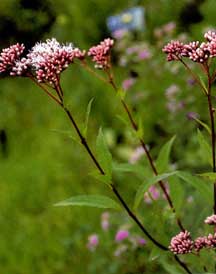 Fujibakama
(Eupatorium fortunei, hemp agrimony or mistflower), has
tiny white blossoms tinged with purple atop long stems.
Originating in China, it has been cultivated in Japan and
can be found along the upper ground of riverbanks. With
some similarities in appearance to ominaeshi, fujibakama
has a subtle fragrance, and the dried plant was worn as
a medicinal sachet. The literal translation is “purple
trousers.” Therefore reference to the flower in poetry
usually connotes a man rather than a woman. Many Kokinshu
poems about fujibakama allude to its fragrance being the
only momento left of a departed lover. Fujibakama
(Eupatorium fortunei, hemp agrimony or mistflower), has
tiny white blossoms tinged with purple atop long stems.
Originating in China, it has been cultivated in Japan and
can be found along the upper ground of riverbanks. With
some similarities in appearance to ominaeshi, fujibakama
has a subtle fragrance, and the dried plant was worn as
a medicinal sachet. The literal translation is “purple
trousers.” Therefore reference to the flower in poetry
usually connotes a man rather than a woman. Many Kokinshu
poems about fujibakama allude to its fragrance being the
only momento left of a departed lover.
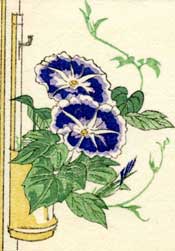 The
last named of the autumn grasses is asagao.
Literally this translates as ‘morning face’ which
in its modern meaning designates the morning glory plant
(Ipomaea purpurea). This creeping plant with trumpet-shaped
blossoms was brought from the Nepalese Himalayas into China,
and then to Heian Japan. Its early cultivation in Japan
failed, but later flourished as the story about Sen Rikyu
and the morning glory garden proves. Rikyu’s canonical
use of morning glories in the tearoom has prompted all
later generations to refrain from imitation and to enjoy
their morning glories in the garden. The
last named of the autumn grasses is asagao.
Literally this translates as ‘morning face’ which
in its modern meaning designates the morning glory plant
(Ipomaea purpurea). This creeping plant with trumpet-shaped
blossoms was brought from the Nepalese Himalayas into China,
and then to Heian Japan. Its early cultivation in Japan
failed, but later flourished as the story about Sen Rikyu
and the morning glory garden proves. Rikyu’s canonical
use of morning glories in the tearoom has prompted all
later generations to refrain from imitation and to enjoy
their morning glories in the garden.
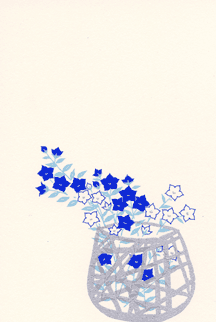 In
Okura’s Manyoshu poem on the seven grasses, as well
as in other Heian literature, the word ‘asagao’
in all likelihood refers to the kikyo (Platycodon
grandifilorum, Chinese bellflower or balloon flower). This
late summer and early autumn flower has five-pointed, purple
trumpet-shaped blossoms, and can be found growing wild in
grassy mountain highlands and in other temperate areas.
Other garden varieties of kikyo include white, pink, and
variegated hues. In
Okura’s Manyoshu poem on the seven grasses, as well
as in other Heian literature, the word ‘asagao’
in all likelihood refers to the kikyo (Platycodon
grandifilorum, Chinese bellflower or balloon flower). This
late summer and early autumn flower has five-pointed, purple
trumpet-shaped blossoms, and can be found growing wild in
grassy mountain highlands and in other temperate areas.
Other garden varieties of kikyo include white, pink, and
variegated hues.
A notable absence in the seven autumn grasses
is kiku (Chrysanthemum sinensis Makino,
chrysanthemum), but this flower is celebrated in its own
right at the festival of the ninth day of the ninth month
Choyo no sekku. The plant was not native to Japan and references
to it were found first in poetry written in Chinese by
Japanese court scholars. Thus it does not appear in the
Manyoshu anthology of Japanese poetry and song, However
chrysanthemum became an important motif in painting, literature,
and other works of art from the Heian period to the present
day.
The capacity of the autumn grasses for inspiring
deep emotion among people in olden days may be viewed through
their composite nature of beauty tinged with sadness. More
than flowers of any other season, autumn grasses washed
by rain and bent in the wind attain a beauty unsurpassed,
and this is the beauty of chabana.

|